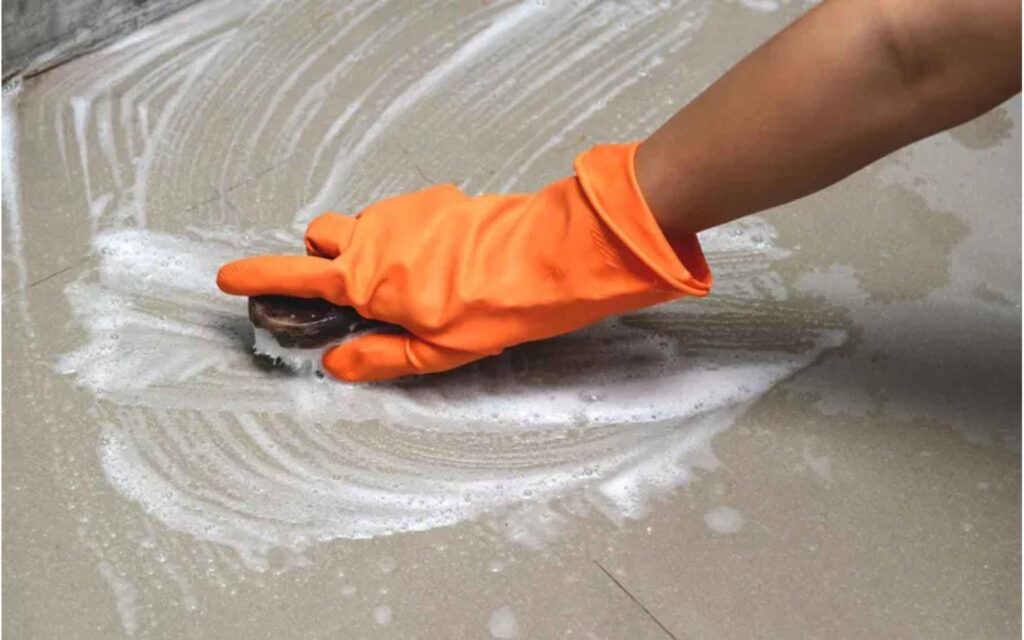Old motor oil stains are stubborn. Unlike fresh spills, these stains have had time to seep into the porous surface of concrete, making them harder to remove. But with the right approach, you can still bring your driveway or garage floor back to a clean, oil-free state.Whether you’re preparing for a house sale, maintaining curb appeal, or just tired of the mess—this guide will show you proven methods to remove even deep-set oil stains from concrete.

Why Are Old Motor Oil Stains Harder to Remove?
Concrete is naturally porous, like a sponge. Over time, motor oil soaks deep into its pores and hardens. If you didn’t catch the spill immediately, simple soap and water won’t work anymore.
👉 For fresh oil spills, follow our guide:
How to Clean Up a Motor Oil Spill on Concrete
What You’ll Need
- Concrete degreaser (biodegradable preferred)
- Scrub brush or broom with stiff bristles
- Absorbent material (e.g., powdered detergent, sawdust, or kitty litter)
- Hot water
- Optional: Pressure washer, poultice cleaner, or commercial oil remover
Step-by-Step: Remove Old Motor Oil from Concrete
Step 1: Pre-Treat the Stain
Sprinkle a dry absorbent (like baking soda or powdered detergent) over the stain to loosen surface grime and soak up any remaining oil residue.
Step 2: Apply a Concrete Degreaser
Choose a degreaser formulated for oil stains on porous surfaces. Spray or pour it directly onto the stain and let it sit for 15–30 minutes.
👉 Need help choosing a product? Check out:
Best Degreasers for Motor Oil on Concrete – Product Review
Step 3: Scrub Vigorously
Use a stiff-bristle brush or broom to scrub the stained area thoroughly. Scrubbing helps lift the oil from deep within the pores.
Step 4: Rinse with Hot Water
After scrubbing, pour hot water over the area to flush away the oil and cleaner. Be sure the runoff drains away from gardens or storm drains.

Advanced Options for Deep Stains
If the stain is still visible after initial cleaning, try one of these advanced methods:
1. Poultice Method
Mix a degreaser or acetone with an absorbent (like flour or sawdust) to form a thick paste. Apply it over the stain, cover it with plastic wrap, and let it sit overnight. Peel it off and rinse.
2. Commercial Oil Removers
Some gel-based oil removers are designed to “pull” oil out of concrete as they dry and peel off. They’re effective but more expensive.
3. Pressure Washing (Final Step)
Use a pressure washer only after applying degreasers—never as the first step, or you’ll push oil deeper into the concrete.
👉 Curious about professional vs DIY? Read this post:
DIY vs Professional Concrete Oil Stain Removal – Which is Better?
When to Repeat the Process
Deep-set stains may require multiple treatments. If you still notice shadows or residue, reapply the degreaser or try the poultice method. Concrete won’t always look brand new—but you can significantly improve its appearance.
Preventing Future Oil Stains
Once you clean your concrete, protect it! Prevention is easier than deep cleaning.
- Use a concrete sealer to block oil penetration
- Place drip pans under vehicles
- Maintain engines to prevent leaks
- Clean small spills immediately
👉 For long-term tips, check out:
How to Prevent Motor Oil Stains on Your Driveway or Garage Floor
FAQs
Q1: Can old oil stains be completely removed?
In most cases, you can fade the stain to an unnoticeable level, but complete removal depends on the depth and age of the stain.
Q2: Is pressure washing enough?
No, pressure washing without a degreaser will likely push oil deeper. Always pre-treat with a cleaning solution first.
Q3: How many times should I treat the same spot?
Some old stains may need 2–3 cleaning sessions. It’s safe to reapply degreasers as needed.
Q4: Can I use household cleaners like dish soap or vinegar?
Dish soap can help clean surface oil, but it’s not strong enough for deep-set stains. Vinegar is not effective for motor oil.



